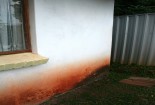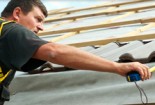Wood Treatments
Wet and Dry Rot
What is Wet Rot?
For wet rot to grow there needs to be fairly high moisture content, if the source of moisture is taken away this growth with come to a stop. This is more common and less serious than dry rot but if left untreated wet rot can cause weakened timbers and serious structural problems within a building.
Signs of wet rot may include a black fungi appearing on timber, cracking and shrinkage and timbers can also feel soft and appear discoloured.
What is Dry Rot?
Dry rot is caused when building timbers are subject to damp; this is a more serious form of fungi decay and can cause significant damage before anybody is aware. It can be caused by many sources, from a leaking roof, an under floor pipe to poorly ventilated areas; dry rot can cause timber to loose structure resulting in weak and brittle foundations. Unlike wet rot it does not need substantial dampness to grow.
The fruiting body releases bacteria destroying both hard and soft woods, this causes deep cracks and eventually the wood breaks down and appears powdery.
Signs of dry rot can include a damp smelling odour, white fungal growth that have the appearance of cotton wool, a red/brown coloured fruiting body may appear and deep cracks are caused within the timber.
Dry / Wet Rot Treatment
Wet and dry rot can be easily mistaken for one another; we will perform a thorough survey to find out the extent of the damage and what treatment the affected area requires.
After we have carried out a complete survey and established the cause and type of rot we can progress with the treatment. This process begins with striping back all areas affected by dry rot, either plasterwork or timbers and treating by pressure injecting a dry rot masonry chemical to brickwork. If the timber is affected a timber replacement and the spraying of surfaces around the affected area is required. After the brickwork treatment is completed we will perform a full re-plaster.
Woodworm
Woodworm beetles can cause potentially destructive damage in buildings, they lay eggs in wooden cracks and when hatched they feed on timber reducing the strength of wood.
Signs of Woodworm
- Small holes in woodwork around 2mm
- A find powder dust around these holes
- Crumbling boards and joist edges
It is important you hire a specialist to assess the area so the correct treatment can be provided. One of our fully trained surveyors will evaluate the damage, pinpointing they type of insect and the extent of structural damage. We can then correctly determine a necessary treatment that is best for you.
All the above carry a company 20 year guarantee, we always provide the most cost effective solutions for our clients.
For a one off fee we can arrange insurance backed guarantees from the GPI this fee is included with in the quotation



Latest News / Projects
-

Different types of damp
There are several different types of damp that you may have in your home and it is important to know the difference. Whilst the symptoms may be similar, the causes can be very different, and so can the treatment that is required. A misdiagnosis may be expensive and may not fix the problem.
Read More -

New website launch
We at Beneck Preservations would like to welcome you to our new website. For the last 20 years, we have prided ourselves on the high quality of our work and we thought it was about time that we had a website that reflects the quality of the work that we provide.
Read More




